Echoes of Iwo Jima: World War II veteran recounts deadly battle for Pacific island
Published 9:25 am Wednesday, February 19, 2020
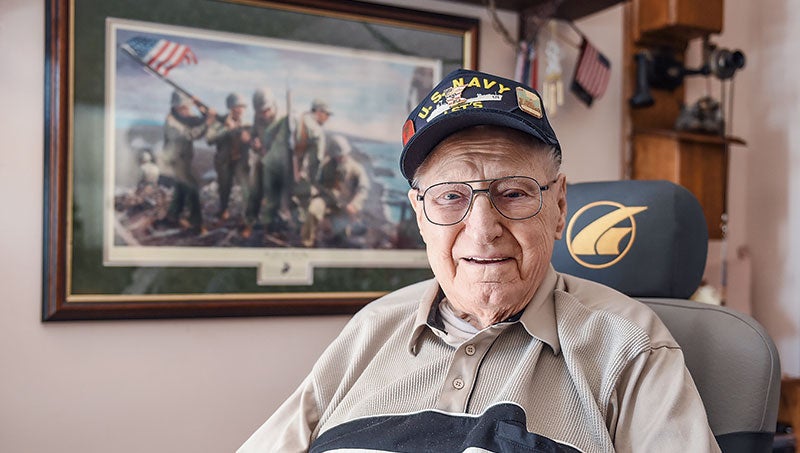
- Erwin Strommer is photographed in front of a painting of the flag raising at Iwo Jima. Strommer was there when the flag was raised and iconic photo was taken. Photos by Eric Johnson/photodesk@austindailyherald.com
|
Getting your Trinity Audio player ready...
|
On the morning of Feb. 19, 1945, U.S. Marines of the Third, Fourth and Fifth Marine Divisions of the U.S. V Marine Amphibious Corps departed ships of the U.S. Fifth Naval Fleet aboard LCVPs (Landing Craft, Vehicle, Personnel). They were in the landing stage of yet another World War II amphibious assault. In the distance was their target – an island about five miles long and 2 ½ miles wide located in the Volcano group of the Bonin Islands. Its name: Iwo Jima.
About 3,000 feet from the shore, larger LSTs (Landing Ship, Tank) launched amphibious sea-going tanks to aid the marines in their assault against the Japanese forces on the island. On the bridges of the LSTs were signalmen responsible for ship communication. Among them was Erwin Strommer, signalman for the USS LST-588.
“It was just this big rock sitting out there,” Strommer said of his first glance of Iwo Jima.
Strommer, who now resides in Austin, was 16-years-old and living in Rockford, Illinois, when he learned about the Japanese attack on Pearl Harbor.
“I was working in a theater and I heard some commotion in the street,” he recalled. “I went out there and there was a boy running down the street yelling, ‘Extra!’ He was telling us that the Japanese had bombed Pearl Harbor.”
Like many of his generation, Strommer wanted to enlist upon hearing the news, but his age prevented him from doing so without permission from his parents. Because they would not sign for him, Strommer had to wait until 1943 before he could enlist in the U.S. Navy.
Strommer took basic training at Naval Station Great Lakes in Illinois, followed by amphibious training at Camp Bradford in Virginia and communications training at the University of Chicago. While in Virginia, he was part of a crew that trained on a mock LST, preparing him for his future role as a signalman in the Pacific Theater.
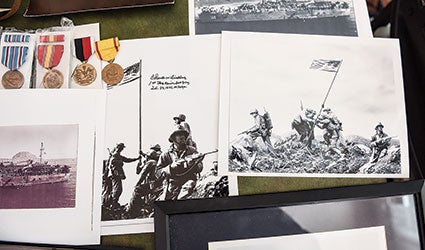
Among the memorabilia from Strommer’s service during World War II, are copies of the first raising of the flag on Iwo Jima.
Operation Detachment
When the Japanese attacked Pearl Harbor in 1941, Japan had already created a massive empire, conquering parts of China, Southeast Asia, the Dutch East Indies (Indonesia) and numerous islands. After Pearl Harbor, the Japanese added more islands, including the Philippines, to their list of conquests.
Because the Empire of Japan encompassed so much water, the Americans employed a strategy known as “island hopping,” invading islands one-by-one and clearing Japanese resistance before moving further. This ensured that the Japanese would have difficulty in disrupting the flow of supplies to American forces as they pushed closer and closer to Japan. It was a daunting task; unlike their Axis Power counterparts in Europe, the Japanese fought with a ferocious tenacity that held death in battle as the greatest honor and surrender as the greatest shame.
By 1945, the Americans had driven back Japanese forces to a handful of islands. In 1944, General Douglas MacArthur had fulfilled his promise to return to the Philippines, and the Americans were preparing for a final push on mainland Japan. But while MacArthur was fighting in the Philippines, Admiral Chester Nimitz planned another invasion in the Central Pacific. He hoped to capture the island of Okinawa, located 350 miles from the southernmost Japanese home island of Kyushu. But before Okinawa could be taken, Nimitz would have to capture Iwo Jima.
Located 660 miles from Tokyo, Iwo Jima (meaning Sulfur Island) contained two Japanese airfields, with a third under construction. To eliminate the Japanese forces on Iwo Jima meant not only depriving them of the airfields, but also giving American forces airfields that were close enough to Japan to allow fighter escorts to accompany bombers on missions over Japan, as well as providing an emergency landing area for damaged American aircraft.
Nimitz hoped to launch the Iwo Jima invasion, dubbed Operation Detachment, on Jan. 2, 1945, but the slow conquest of Leyte in the Philippines postponed the invasion date. After three days of shelling the island, the invasion of Iwo Jima began at about 9 a.m. on Feb. 19.
“There was a lot of activity going on; the battleships were firing shells onto it and airplanes were bombarding it and dropping napalm,” Strommer said of the pre-invasion bombardment to soften the Japanese defenses.
Awaiting the marines were about 21,000 Japanese soldiers commanded by Gen. Tadamichi Kuribayashi. Unlike in previous amphibious invasions, Kuribayashi ordered his men to wait until the Americans were on the beaches before opening fire. Using the island’s cave system to their advantage, the Japanese established pillboxes, bunkers and blockhouses for defenses.
Once the marines were on the beach, Kuribayashi ordered his men to open fire.
“We couldn’t see any Japanese activity until after we were on the beach,” Strommer recalled. “I saw my first Japanese soldier – he had come out of one of those mole holes on the beach – and he was trying to give up. One of our sea-going tanks came by and he was run over right in front of the ship. The marines were huddled on the beach under that heavy fire.”
But the marines were not the only ones under fire. As the LSTs sent out tanks and observed the battle from offshore, the Japanese began directing their fire at them. Strommer was on the bridge of LST-588, keeping in contact with the crew and other ships as the Japanese targeted them with mortars.
“Most of the time, we were trying to find a corner to get down into because we were getting shelled from the beach,” he remembered. “We thought all of this activity was coming from Mt. Suribachi; the marines were climbing up that and occasionally we would see a puff of smoke from the flamethrowers when they would get a shot at one of the caves. Come to find out, we were getting all of the shellfire from somewhere else. Just as I turned the corner, a shell hit right where I had been standing. I assumed I was the target and I just happened to turn. We measured it (the damage to the ship) when I stood there afterwards. It would have taken my left shoulder right off.”
Some crew members took the shelling as an opportunity to acquire a souvenir.
“There was tons of shrapnel raining on the deck and I kept hearing someone saying, ‘I found one, I got one! Ooh, it’s hot!’” Strommer said. “Someone had been crawling around the deck picking up pieces of shrapnel for souvenirs.”
“Fortunately, with all of the shell holes on the side of the ship and various places, we went through all of that and never lost a man,” he added.
By the end of the day, the Fifth Marine Division had pushed its way across the narrowest point of the island, isolating Mount Suribachi, an ancient volcano at the southern tip of Iwo Jima. While the Third and Fourth Marine Divisions turned their attention north, the Fifth began the assault on the Japanese forces on Mount Suribachi.
LST-588 beached on the second day of the invasion.
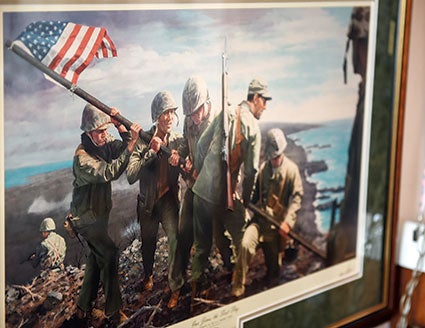
A painting of the flag raising hangs in Erwin Strommer’s living room.
Old Glory
The battle was still raging on Iwo Jima on the morning of Feb. 23. On board LST-588, Strommer saw marines making their way up Mount Suribachi.
“Every now and then, I would see a puff of smoke when Chuck Lindberg would give them a shot with his flamethrower,” he said, referring to his friend Cpl. Charles Lindberg.
LST-588 was repositioned as the morning continued. When the ship was anchored, Strommer saw something on Mount Suribachi that boosted morale.
“Being the signalman up on the bridge, I was the one that was able to open that voice tube and call down, “Hey, the flag’s flying!’” he recalled.
What Strommer saw was the first American flag raised on the summit of Mount Suribachi by men of Company E, 28th Marines, Fifth Marine Division. Present at Iwo Jima was Navy Secretary James Forrestal. As the story goes, Forrestal witnessed the raising and ordered Col. Chandler Smith to bring the flag to him as a memento. As a result, the first flag was taken down and a second flag was raised. It was the raising of the second flag that was captured in Associated Press photographer Joe Rosenthal’s iconic image.
“The sad part of it is that those men (who raised the first flag) got very little publicity,” Strommer said. “Half of them were either killed or wounded. Chuck was wounded too. He was trying to promote the first flag and the Marine Corps was doing just the opposite. Those guys who raised the second get all of the credit.”
In the end, Forrestal never got the first flag; both the first and second flag were turned over to the National Museum of the Marine Corps.
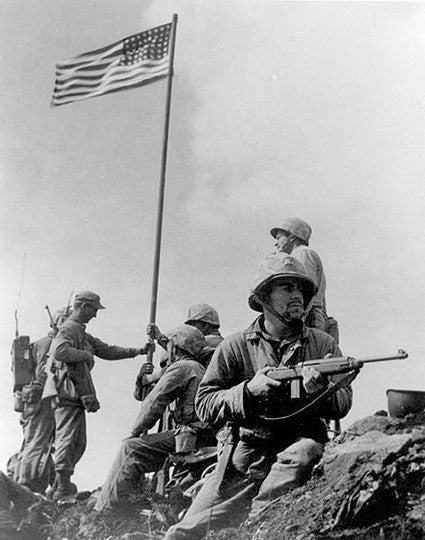
This photo, taken by Staff Sgt. Louis Lowery, shows the raising of the first American flag on the summit of Mount Suribachi, Feb. 23, 1945. Corp. Charles Lindberg can be seen standing in the back on the far right. Of the men pictured, two of them, Sgts. Ernest Thomas Jr. and Henry Hansen, were killed later in the battle. Photo provided
The aftermath
As the battle continued, casualties on both sides rose. Knowing that suicide charges had decimated Japanese forces in prior battles, Kuribayashi urged his men to maintain their defenses. Some Japanese soldiers volunteered to strap explosives on their bodies and lie in the path of American tanks. The tactic worked in slowing the Americans, who used flamethrowers, carried by marines and mounted on tanks, and TNT to destroy the Japanese defenses.
The marines gradually wore down the Japanese; what remained of the garrison eventually resorted to suicide attacks. Fighting ended on March 23.
Iwo Jima went down in history as the deadliest battle fought by the Marine Corps in World War II. The Marine Corps suffered over 6,000 killed (roughly one-third of all marines killed in World War II) and 17,000 wounded. Of the 21,000 Japanese defenders, virtually all, including Kuribayashi, were killed.
Nimitz said that among the marines at Iwo Jima, “Uncommon valor was a common virtue.”
In the end, the battle may not have been necessary. The Americans switched to night bombings of Japan, negating the need for fighter escorts; however, the island did prove valuable as a base for damaged aircraft to make emergency landings.
Although Iwo Jima was in American hands, the situation was not completely free of danger. After participating in the attack on Okinawa, Strommer and LST-588 returned to Iwo Jima.
“On our second trip to Iwo Jima, when the island was secure, we would occasionally get air raids from Japan,” Strommer recalled. “Our night fighters normally intercepted those and they never got to the island. One of them did on my watch. It was a nice quiet night when a gunnery officer came and grabbed a knife and cut a hole in a sheet the signalmen had put up as protection from the sun. He said, ‘Air raid! Air raid!’ We were on the end of a line of anchored ships and we saw this light coming and heard a few bombs drop. We saw the plane coming straight at us and all of these tracer bullets were going every which way across. The plane still kept coming on and was heading toward the bridge of the ship. Just before it got to us, we saw the tail go. It was a Japanese Betty (Mitsubishi G4M bomber). It went over us just between the mast and the bow at an angle and crashed right alongside us.
“I can still see the pilot and the bombardiers’ silhouettes against the flames that were coming out of the engine.”
Strommer eventually returned to Okinawa; it was there that he learned of Japan’s surrender.
“It was probably more dangerous than some of the activities we were into,” he said with a laugh. “The first one we got was a false surrender that came through. All of these ships were trying to write ‘victory’ in the sky with all of these tracers and shells. With all of this anti-aircraft, it was like being in a hailstorm; shrapnel was falling all over the deck. That was a mess. When it (the real surrender) did finally come through, all hell broke loose, and that’s all I can say.”
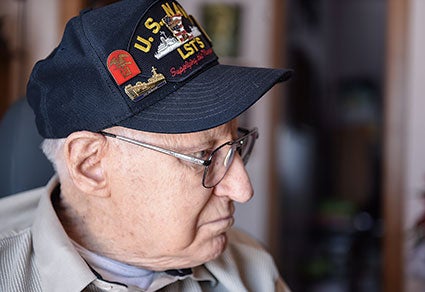
Erwin Strommer was there at Iwo Jima the day the flag was raised and was able to report “Hey, the flag’s flying.”
Coming together
After serving occupation duty in China, Strommer re-enlisted in the Navy, eventually retiring with credit for 13 years of service. But his connection to the Battle of Iwo Jima did not end there. Later in life, he befriended Rosa Ogawa, the daughter of Imperial Japanese Army Capt. Taunezo Wachi, who was garrison commander at Iwo Jima shortly before the American invasion.
“(The Japanese) released him (from command) believing that he would not sacrifice his troops,” Strommer said.
Wachi founded the Iwo Jima Association, an organization dedicated to returning items taken during the battle back to Japan. Strommer had such a souvenir – a journal that belonged to a Japanese soldier killed at Iwo Jima.
“(Wachi) started this return to Iwo campaign for sending things back to Japan; souvenirs that marines had picked up during the battle,” Strommer said. “That’s when I sent that journal back.”
Strommer kept up correspondence with Ogawa until the Tohoku earthquake and tsunami that occurred on March 11, 2011.
“After that last tsunami, I never heard from her again,” he said. “We’re trying to find out if she and the family are still alive.”
As for Iwo Jima, the memories are still there 75 years later.
“I can’t say if I was afraid,” Strommer said. “It’s a strange sensation and you did what you had to do.”
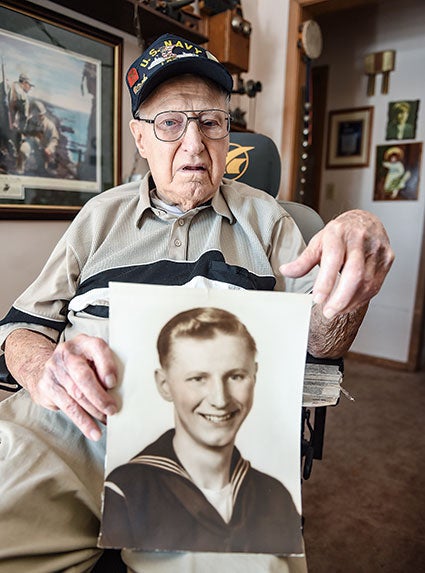
Erwin Strommer shows off a picture from his service days in the Navy.


